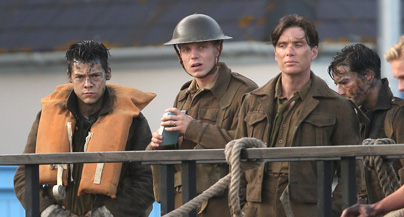Movie Review: Dunkirk
By Steven Slater
August 1, 2017
BoxOfficeProphets.com

Dunkirk tells the story of one of those miracle moments during World War II, where the chances for catastrophe were high, and any outcome other than the one that occurred could have spelled doom for the resistance to Nazi Germany. Hundreds of thousands of troops, most from Britain, were cornered by the Germans onto a small stretch of beach on the narrow English Channel. Nolan’s film is very focused on the evacuation itself, beginning as the Allies are already hunkered down in Dunkirk, and ending as one of the men arrives home. The plot concerns three arcs; the men on the beach who have to wait a week for salvation, the private boats drafted into service from the English coast, and the pilots flying daring missions across the channel to give what fight they can to Hitler’s Luftwaffe.
Nolan attempts to combine the tension from each by intercutting them as though they occur simultaneously. This can have odd consequences, such as one storyline switching between day and night while another maintains a continuous arc in daylight, as well as showing us events multiple times. Perhaps Nolan became addicted to this technique after the great success it achieved way back with Memento, and in Dunkirk I can understand the logic from a narrative standpoint (otherwise the aerials would only occur during the last few minutes of the film!), but it seems to confuse the story more than aid the impression. Regardless, it definitely allows Tom Hardy and his incredible flying stunts to be showcased to great affect. My favorite shot of the film is the Spitfire plane gliding without any more fuel, silently over the sunset lit cityscape of Dunkirk. It is an exact emotional analogue to that shot in The Dark Knight where the Joker hangs out of the cop car. In a film with Hans Zimmer scoring and Nolan’s tendency for mixing loud, the silent moments tend to speak with the most volume.
Some of the scenes are truly harrowing, in a way only Nolan can construe with real ships, water, actors, and minimal CGI. His method of filmmaking achieves a massive sense of scale, and when the U-boats and aerial bombardments sink the English destroyers, the IMAX scenes strike right to the bone of fear. Almost the entire film was photographed in IMAX 70mm, a bravura achievement unlikely to ever be topped. Hoyte Van Hoytema and Nolan do things with a 50-pound camera you never thought possible, using it as nimbly as a GoPro. The fact that Nolan prefers timing on film as opposed to digitally also lends the film an older feeling; some of the 70mm footage not in IMAX (about 25 percent was shot in 5-perf 70mm, like Lawrence of Arabia or The Hateful Eight) looks straight out of the 1960s, fitting the type of film if not the more modern filmmaking.
Oddly, unlike many of Nolan’s films, I cannot say that any of the performances are particularly striking. The actors and their roles are not really the star of this show. Instead, they merely fill parts to flesh out the larger tale of desperation. Kenneth Branagh seems a bit wasted, and the fact that we learn almost no one’s name means we hardly attach ourselves to anyone. Tom Hardy has the deepest emotional arc in my opinion, which is ironic considering his face is obscured once again.
So what is it that I feel keeps Nolan’s films from becoming true masterpieces? His editing. I hate his editing. Lee Smith has done other films that I liked, so I do not think it is him; rather it is Nolan’s tendency to experiment with the form of editing. The issue is I always find his editing is rooted in logic, not emotion, and so often it becomes an exercise in style, something to be pondered over, rather than able to help the film convey the story. In the end, that leaves his movies cold and unaffecting, for me at least, in a way that directors like Stanley Kubrick were able to overcome. When Peter O’Toole demanded to know why he had to ride a camel a mile away in a shot, David Lean quipped in reply that without Peter there was “No Poetry.”
I cast a similar charge against Christopher Nolan. He commands the craft of filmmaking like no other, and yet he refuses to admit his own weaknesses. He needs to leave the emotional storytelling to the editor, and stop playing around with temporal scales. A good example of this is Ridley Scott’s early work in Alien and Blade Runner. I don’t think Scott necessarily was a great director when it came to eliciting emotion from his performers. Rather, his sense of imagery was profound, and Terry Rawlings, editor on both films, turned it into a dream (or nightmare) like elegy. Nolan needs an editor like Terry Rawlings; the power of his films could be remarkable. Maybe I should put my money where my mouth is and take one of his movies and re-edit the footage.
I will always support Nolan and his films, as he is a unique voice in cinema, and at times he works magic. But he frustrates me, and I cannot call Dunkirk a masterpiece, although it feels close to one. See it in 70mm IMAX if you can.
Slater Grade: B+